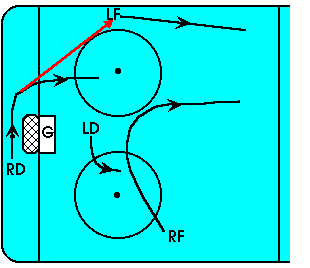Breakout Options -- by Greg Siller
Breakout plays are used by a team to move the
puck out of their defensive zone and onto an offensive attack. Every coach/team
should establish some fundamental breakout plays early in the season and ensure
that at least two options are designed into each of these plays.
1. Gaining initial control of the puck. Players must not move to their
breakout positions until the team has control of the puck. All players need to
read, anticipate, and react to know when to drop their defensive coverage and
get into position for a breakout. If players move prematurely, they may be
leaving their opponents open for a quick scoring opportunity if the opposition
gains control of the puck.
2. Creating space through player positioning and movement. Space is
needed for the breakout play to develop. The positioning and movement of the
forwards and defensemen depends upon puck position, forechecking intensity,
team abilities, and how aggressive, conservative, or creative the coach is with
the breakout play. Although many breakouts appear to involve only one or two
players in the execution of the play, all players need to assume a role to
enhance the likelihood of success. This point reflects the necessity for team
play during a breakout; by creating space as a team, you create options for
the team.
3. Maintaining puck control. No turnover is more dangerous than one that
occurs in your defensive zone. The first pass must be accurate. If it isn't,
the receiver should do everything possible to regain control of the puck. It is
essential that all receivers control the puck after receiving a pass.
 The strong side breakout
is the most fundamental breakout play in hockey. However, by adding a few
options to this play (or any other breakout play), it becomes more than
fundamental. The objective of the strong side breakout is to move the puck up
the playing surface using the strong side forward (the forward that is on the
same side of the playing surface as the puck). The advantage of the strong side
breakout is that it is generally low risk. In the figure, RD gains control of
the puck (key #1) deep in the defensive zone, reads that there is minimal
coverage on the left side of the playing surface, and skates behind the net to
the left side. As he moves out from behind the net, he passes the puck to LF.
This first pass is the most critical one in the breakout (key #3).
The strong side breakout
is the most fundamental breakout play in hockey. However, by adding a few
options to this play (or any other breakout play), it becomes more than
fundamental. The objective of the strong side breakout is to move the puck up
the playing surface using the strong side forward (the forward that is on the
same side of the playing surface as the puck). The advantage of the strong side
breakout is that it is generally low risk. In the figure, RD gains control of
the puck (key #1) deep in the defensive zone, reads that there is minimal
coverage on the left side of the playing surface, and skates behind the net to
the left side. As he moves out from behind the net, he passes the puck to LF.
This first pass is the most critical one in the breakout (key #3).
Once LF controls the puck, the other players continue to contribute to the
breakout play by creating space and providing various options for LF (key #2).
LF now has three options: skate with the puck, pass it, or dump it (as a last
resort). Adding options to your breakout plays add depth and the ability to
succeed in its execution no matter what the opposition does to counter your
play.
Contact Greg Siller @ Pro Learning
Systems